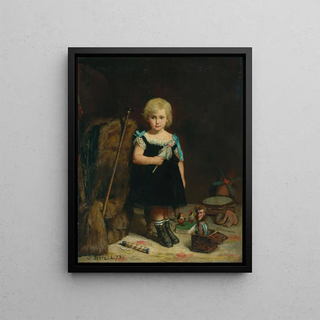Art print | Portrait of Alfred Auguste Frédéric Victor Labatt de Lambert - Jean Béraud


View from behind

Frame (optional)
The "Portrait of Alfred Auguste Frédéric Victor Labatt de Lambert" by Jean Béraud is a work that transcends the simple frame of a painting to offer a true glimpse into the human soul. Painted at the turn of the 20th century, this art print is much more than a faithful representation of a person; it is an open window onto an era, a reflection of the customs and aspirations of a society in full transformation. Through this masterpiece, Béraud succeeds in capturing not only the appearance of his subject but also their essence, character, and social status. Light, color, and composition come together to create an atmosphere that is both intimate and universal, engaging the viewer in deep contemplation.
Style and uniqueness of the work
Jean Béraud's style is often characterized by meticulous attention to detail and exceptional mastery of light. In this art print, each brushstroke seems carefully chosen to evoke the texture of clothing and the delicacy of Labatt de Lambert's features. The colors, rich and nuanced, add an almost tactile dimension to the canvas, allowing the viewer to feel the presence of the subject. Béraud excels in the art of staging, creating a background that, although discreet, contributes to the visual storytelling. The posture of the figure, slightly turned towards the viewer, invites silent dialogue, an interaction that transcends time. This art print is an iconic work that illustrates Béraud's talent for marrying realism and sensitivity, capturing not only appearance but also the soul of his subjects.
The artist and his influence
Jean Béraud, a prominent figure of 19th-century French painting, established himself through his unique style and his ability to depict everyday life with rare emotional depth. Influenced by the artistic currents of his time, notably realism and impressionism, Béraud developed a personal approach that combines precise observation and personal interpretation. His work is often perceived as a mirror of Parisian society, where he depicts scenes of urban life with keen sensitivity. The "Portrait of

Matte finish

View from behind

Frame (optional)
The "Portrait of Alfred Auguste Frédéric Victor Labatt de Lambert" by Jean Béraud is a work that transcends the simple frame of a painting to offer a true glimpse into the human soul. Painted at the turn of the 20th century, this art print is much more than a faithful representation of a person; it is an open window onto an era, a reflection of the customs and aspirations of a society in full transformation. Through this masterpiece, Béraud succeeds in capturing not only the appearance of his subject but also their essence, character, and social status. Light, color, and composition come together to create an atmosphere that is both intimate and universal, engaging the viewer in deep contemplation.
Style and uniqueness of the work
Jean Béraud's style is often characterized by meticulous attention to detail and exceptional mastery of light. In this art print, each brushstroke seems carefully chosen to evoke the texture of clothing and the delicacy of Labatt de Lambert's features. The colors, rich and nuanced, add an almost tactile dimension to the canvas, allowing the viewer to feel the presence of the subject. Béraud excels in the art of staging, creating a background that, although discreet, contributes to the visual storytelling. The posture of the figure, slightly turned towards the viewer, invites silent dialogue, an interaction that transcends time. This art print is an iconic work that illustrates Béraud's talent for marrying realism and sensitivity, capturing not only appearance but also the soul of his subjects.
The artist and his influence
Jean Béraud, a prominent figure of 19th-century French painting, established himself through his unique style and his ability to depict everyday life with rare emotional depth. Influenced by the artistic currents of his time, notably realism and impressionism, Béraud developed a personal approach that combines precise observation and personal interpretation. His work is often perceived as a mirror of Parisian society, where he depicts scenes of urban life with keen sensitivity. The "Portrait of






